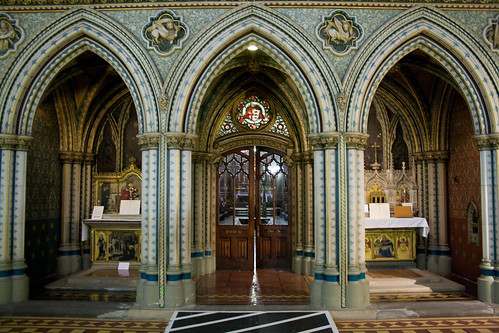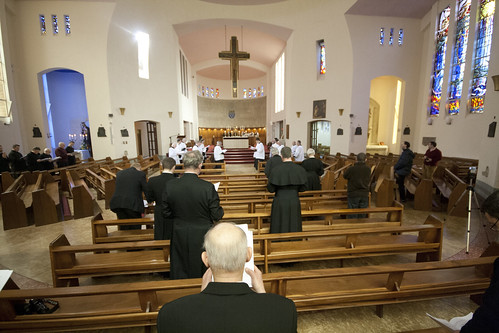Traditional High Mass will be celebrated at St Walburgh's, Preston, at 10am on Sunday 5th May 203.
St Walburgh's, Preston, is a famous church whose future has long been in doubt, in a part of England with a great Catholic tradition. If you are within reach of this Mass, please support it. See it on a map here.
Labels
- Bishops
- Chant
- Children
- Clerical abuse
- Conservative critics of the EF
- Correctio Filialis
- FIUV Position Papers
- Fashion
- Freemasonry
- Historical and Liturgical Issues
- Islam
- Liberal critics of the EF
- Marriage & Divorce
- Masculinity
- New Age
- Patriarchy
- Pilgrimages
- Pope Francis
- Pro-Life
- Reform of the Reform
- Young people
Tuesday, April 30, 2013
Ordinations, Catholic Voices, and moving averages
I don't want to become obsessed with this subject (to which the background is here), but Catholic Voices has put out - together with a very handsome apology - a rather puzzling bit of statistical analysis designed to salvage something of their original claim, that things today are as good or better than they were in the 1950s: an analysis of the data provided by Stephen Morgan by a 'decadal' (ie 10-year) 'moving average'.
Here it is. Click to enlarge.

Another point to note is that, for some reason, the religious orders supplied a larger proportion of ordinations after the War than they had before the War; indeed their numbers were higher in the 1950s than in the 1930s. So looking at only ordinations of the secular clergy is misleading: the total number of ordinations, secular and religious, peaked at 250 in 1937, and then at 243 in 1956. The difference between those two numbers is not something I would want to build any grand narrative upon. See my post on the religious orders here.
It is impossible to say what would have happened if it had not been for the second world war. Many young men were killed before they could choose a profession. Others were perhaps inspired by their experiences to dedicate themselves to God. The same, conflicting, results no doubt manifested themselves after the First World War. But as far as the statistics are concerned, the contrast between the 1930s peak and the 1950s peak is not nearly so marked as Catholic Voices is claiming.
Perhaps another apology would be asking too much, but please Catholic Voices, either explain what I have failed to understand, or remove this dreadful graph.
Here it is. Click to enlarge.

I can't claim to have any great statistical expertise, but a 'ten-year average' is an average of the last ten years, and a 'moving average' is when you plot those averages on a graph. To be honest, I am more than a little baffled by the graph above. For one thing, I think its creator, Joe Ronan, has forgotten to divide the totals for each decade (the ten years up to 1922, the ten years up to 1923 etc.) by ten: instead of an average of 145 ordinations a year in the decade up to 1936, for example, he has plotted 1,450, the total number of ordinations for the decade.
But above all, I'd like to know what he did when he had a year in which there was no data. Did he put in an average? Or zero?
There were four missing years of data in the 1950s in the data Stephen Morgan supplied: 1951, 1952, 1956 and 1957. For the decade up to and including 1958, the six years for which Stephen supplied data told us about 544 ordinations. Not bad for 6 years: we now know that the total for that decade was a stonking 1,106. Ok, Joe Ronan didn't know that, though if the guy updating the CV blog today had checked Rorate Caeli first it would have been kind to tell him that more data was now available. Never mind. But with a gap in the data, what Joe Ronan should have done is divide 544 (the total for six years) by six and multiply by ten, which would have given him an estimated average for the decade of 91, or an estimated total for the decade of 906, a figure far below the real one but at least methodologically defensible. What the graph appears to show, however, is 544. Oh dear, oh dear.
What that dip in the red line in the course of the 1950s shows is not that ordinations fell, but simply that the Portsmouth Diocese archive (where Stephen Morgan got his data) is missing a few editions of the Catholic Directory.
I don't want to be rude to some volunteer at Catholic Voices who is, I assume, doing his best. But please, Catholic Voices: get a grip. You are putting this stuff out into the public domain.
Now, the point of the graph is that the post-war rise in ordinations is so much less impressive than the inter-war rise in ordinations, that it makes sense to look at the graph overall as a decline starting in the 1930s. Since we now have the full set of data for the 1950s at least, I've created a graph using the number of secular ordinations and a (real) ten-year moving average. As you'd expect, the moving average is a smoother line which is below the main data line when that is in an upward trend, and above it when it is in a downward trend. (That is what moving averages are for, to show long-term trends.) The missing data for the 1950s made unclear just how strong the post-war rebound in ordinations was.
Another point to note is that, for some reason, the religious orders supplied a larger proportion of ordinations after the War than they had before the War; indeed their numbers were higher in the 1950s than in the 1930s. So looking at only ordinations of the secular clergy is misleading: the total number of ordinations, secular and religious, peaked at 250 in 1937, and then at 243 in 1956. The difference between those two numbers is not something I would want to build any grand narrative upon. See my post on the religious orders here.
It is impossible to say what would have happened if it had not been for the second world war. Many young men were killed before they could choose a profession. Others were perhaps inspired by their experiences to dedicate themselves to God. The same, conflicting, results no doubt manifested themselves after the First World War. But as far as the statistics are concerned, the contrast between the 1930s peak and the 1950s peak is not nearly so marked as Catholic Voices is claiming.
Perhaps another apology would be asking too much, but please Catholic Voices, either explain what I have failed to understand, or remove this dreadful graph.
More statistics: the Religious Orders
Update: Catholic Voices have apologised for their earlier mistake: all credit to them. They are, however, still behind the curve, since they have subjected Stephen Morgan's gappy numbers to another kind of statistical analysis, a ten-year moving average. I'd like to see this re-done with the full set of data for the 1950s. However I also think it is a largely meaningless exercise to debate whether we should talk of a peak in 1937 or in 1956, because of the effect of the second world war.
I now have complete statistics for ordinations in the 1950s - the numbers Deacon Stephen Morgan (@trisagion) compiled had gaps, because of gaps in his archive of Catholic Directories. As far as the 1950s are concerned, the gaps are now filled.
Go to Rorate Caeli to see the whole story. Between 1956 and 2008, numbers of ordinations to the secular clergy collapsed (in round numbers) by 90%: from 246 to 15.
Below is a revised graph. As well as adding the statistics from the National Office of Vocations for secular ordinations since 1982, I've now added their statistics for 'entry' into 'Order Priests' (sic), which they say they have from the Conference of Religious Superiors. I must say I find this a baffling and frustrating formula: what does it mean? Is a Benedictine monastery an 'order [of] priests', or (the alternative) an 'order [of] brothers'? Or does this mean priests or brothers joining orders? Except that they don't - they join as postulants, then they are novices, then they may be ordained, or not. So what does 'entry' mean: the novitiate, or solemn (permanent) profession? How many drop out between 'entry' and ordination? Is the column for priests double counting the column for brothers, where non-ordained members are 'brothers'? What happens when a secular cleric joins an order - is he counted? Why are these numbers so much higher than the statistics for ordinations by the religious orders in 1982-1988 given by the Catholic Directories for those years? And why is the data for 1988 missing? Why can't they just give us a record of ordinations to the priesthood in religious orders?
Nevertheless, for what it is worth, here it is. If what they are measuring is consistent, it gives us an idea of the trend, if nothing else. The trend is similar to that for secular ordinations, without the filip from the Anglican converts in the mid-1990s. It bottomed out slightly earlier, with 10 entrants in 1993, a collapse of 90% from the peak of 101 in 1961. Except the figure for 1961 is for ordinations, so the collapse is bigger than that.
But wait, but wait! The decline of the Church since the Second Vatican Council is a myth! So all these statistics are wrong, our eyes are playing us tricks, the empty churches are an illusion, the closure of seminaries isn't really happening, just put on these green glasses and you will realise that the city you inhabit is made of emerald!
The Excel file with the numbers and graph can be downloaded here.
I now have complete statistics for ordinations in the 1950s - the numbers Deacon Stephen Morgan (@trisagion) compiled had gaps, because of gaps in his archive of Catholic Directories. As far as the 1950s are concerned, the gaps are now filled.
Go to Rorate Caeli to see the whole story. Between 1956 and 2008, numbers of ordinations to the secular clergy collapsed (in round numbers) by 90%: from 246 to 15.
Below is a revised graph. As well as adding the statistics from the National Office of Vocations for secular ordinations since 1982, I've now added their statistics for 'entry' into 'Order Priests' (sic), which they say they have from the Conference of Religious Superiors. I must say I find this a baffling and frustrating formula: what does it mean? Is a Benedictine monastery an 'order [of] priests', or (the alternative) an 'order [of] brothers'? Or does this mean priests or brothers joining orders? Except that they don't - they join as postulants, then they are novices, then they may be ordained, or not. So what does 'entry' mean: the novitiate, or solemn (permanent) profession? How many drop out between 'entry' and ordination? Is the column for priests double counting the column for brothers, where non-ordained members are 'brothers'? What happens when a secular cleric joins an order - is he counted? Why are these numbers so much higher than the statistics for ordinations by the religious orders in 1982-1988 given by the Catholic Directories for those years? And why is the data for 1988 missing? Why can't they just give us a record of ordinations to the priesthood in religious orders?
Nevertheless, for what it is worth, here it is. If what they are measuring is consistent, it gives us an idea of the trend, if nothing else. The trend is similar to that for secular ordinations, without the filip from the Anglican converts in the mid-1990s. It bottomed out slightly earlier, with 10 entrants in 1993, a collapse of 90% from the peak of 101 in 1961. Except the figure for 1961 is for ordinations, so the collapse is bigger than that.
The Excel file with the numbers and graph can be downloaded here.
Saturday, April 27, 2013
Ordination Statistics for England and Wales
The diligent Rev Stephen Morgan (@trisagion) and some chums have been through a huge pile of old Catholic Directories to answer the question posed by Catholic Voices and the Vocations Office: how do ordinations today, with their current upswing, compare with those of previous decades? I've parked his raw data on the Latin Mass Society site here.
To recap, the Vocations Office printed some very strange-looking figures for the period before 1980, with average annual numbers of ordinations given for each decade weirdly low: 6 for the 1930s, for example. Catholic Voices posted an article on their own blog which leapt on these to make the counter-intuitive claim that we are enjoying a higher number of ordinations now than in the 1950s. When questioned on this, the Vocations Office pulled their pre-1980 figures. Catholic Voices say they are 'looking into it.'
As TTony might say, hmm.
I have turned Deacon Morgan's columns of figures into two graphs: one showing ordinations, the other, the total number of clergy. These are figures from the Catholic Directory year by year, and they stop in the 1980s, when the Directory stopping publishing them (at least, in the same format). Where a Directory was missing from the archive he was using, there is a gap in the line, but the general picture remains very clear. I have added the year-by-year numbers since 1980 given by the Vocations Office, as a separate line. The Directories distinguished ordinations for Secular and Religious clergy; I include both lines of numbers plus a 'total' for the two together; the Vocations Office statistics are supposed to be secular clergy only.
(Double-click to see them bigger.)
The Vocations Office is clearly counting differently from the Directories, and have higher figures where the two series overlap. There are a number of possible explanations. (Are they counting ordinations to the permanent diaconate? Is there some inconsistency between the two series about the treatment of non-religious communities of priests like the Oratorians?) It doesn't matter: they show they same trend, of steep decline starting in the mid 1960s.
In the 1950s and 1960s there were, almost every year for which there are figures, more than 200 ordinations. The twin bounces provided by the Papal Visit of 1982 and the Anglican influx after 1992 are very visible; we even managed just over 100 for two years. This year we are overjoyed to be anticipating 41 secular ordinations, not counting the Ordinariate, which (Catholic Voices say) should add another 11. Great. In 1937, the number of secular vocations was over 150; that was in a year that the religious orders ordained 80 men to the priesthood.
Another source has scanned the relevant pages of the Directory for 1940 and 1941; I have put these on my Flickr page. If you need persuading that this avalanche of clergy in the mid century was real, you can read their names. (And you can note, they aren't all Irish names.) Under 'Ampleforth' I see the legendary Fr James Forbes, later a Master of St Benet's Hall. Oh, these chaps were real enough.
I sincerely hope that Catholic Voices has the sense to modify or scrap that blog post of theirs. In the interests of posterity, here is the money quote in a screenshot taken today.
The obvious fact about the statistics is the horrible and persistent decline which started in the mid 1960s, in both ordinations and clergy numbers. The latter reflects the tragic mass laicisations of the 1970s and 1980s.
It hasn't. Just before the crash landing things changed. This is now the fifth year running of improving numbers. It is nothing like enough to replace the priests dying and retiring: the ones ordained forty years ago. But it a lot better than nothing. It is not to be minimised, but not to be exaggerated either. Let's be sensible about it for heaven's sake, and pray for vocations.
To recap, the Vocations Office printed some very strange-looking figures for the period before 1980, with average annual numbers of ordinations given for each decade weirdly low: 6 for the 1930s, for example. Catholic Voices posted an article on their own blog which leapt on these to make the counter-intuitive claim that we are enjoying a higher number of ordinations now than in the 1950s. When questioned on this, the Vocations Office pulled their pre-1980 figures. Catholic Voices say they are 'looking into it.'
As TTony might say, hmm.
I have turned Deacon Morgan's columns of figures into two graphs: one showing ordinations, the other, the total number of clergy. These are figures from the Catholic Directory year by year, and they stop in the 1980s, when the Directory stopping publishing them (at least, in the same format). Where a Directory was missing from the archive he was using, there is a gap in the line, but the general picture remains very clear. I have added the year-by-year numbers since 1980 given by the Vocations Office, as a separate line. The Directories distinguished ordinations for Secular and Religious clergy; I include both lines of numbers plus a 'total' for the two together; the Vocations Office statistics are supposed to be secular clergy only.
(Double-click to see them bigger.)
The Vocations Office is clearly counting differently from the Directories, and have higher figures where the two series overlap. There are a number of possible explanations. (Are they counting ordinations to the permanent diaconate? Is there some inconsistency between the two series about the treatment of non-religious communities of priests like the Oratorians?) It doesn't matter: they show they same trend, of steep decline starting in the mid 1960s.
In the 1950s and 1960s there were, almost every year for which there are figures, more than 200 ordinations. The twin bounces provided by the Papal Visit of 1982 and the Anglican influx after 1992 are very visible; we even managed just over 100 for two years. This year we are overjoyed to be anticipating 41 secular ordinations, not counting the Ordinariate, which (Catholic Voices say) should add another 11. Great. In 1937, the number of secular vocations was over 150; that was in a year that the religious orders ordained 80 men to the priesthood.
Another source has scanned the relevant pages of the Directory for 1940 and 1941; I have put these on my Flickr page. If you need persuading that this avalanche of clergy in the mid century was real, you can read their names. (And you can note, they aren't all Irish names.) Under 'Ampleforth' I see the legendary Fr James Forbes, later a Master of St Benet's Hall. Oh, these chaps were real enough.
I sincerely hope that Catholic Voices has the sense to modify or scrap that blog post of theirs. In the interests of posterity, here is the money quote in a screenshot taken today.
The obvious fact about the statistics is the horrible and persistent decline which started in the mid 1960s, in both ordinations and clergy numbers. The latter reflects the tragic mass laicisations of the 1970s and 1980s.
Now I am by no means a fundamentalist when it comes to explaining everything in terms of Vatican II: I've blogged about the broader social factors at work. But facts must be faced. The blips upwards in the 1990s were just that - blips. You can see the trend reasserting itself after the bulge, as if nothing had happened. That trend would have taken us to zero by now had it continued.
It hasn't. Just before the crash landing things changed. This is now the fifth year running of improving numbers. It is nothing like enough to replace the priests dying and retiring: the ones ordained forty years ago. But it a lot better than nothing. It is not to be minimised, but not to be exaggerated either. Let's be sensible about it for heaven's sake, and pray for vocations.
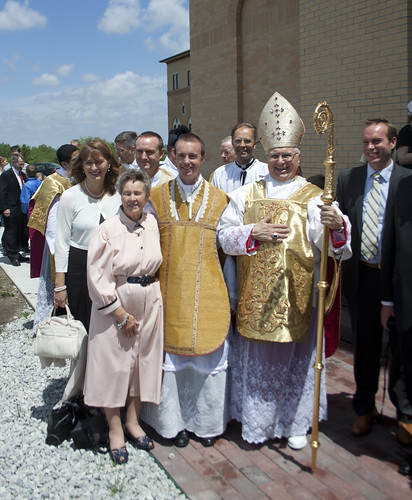 |
| A newly ordained Englishman of the Fraternity of St Peter, with Bishop Bruskevitz of Lincoln, Nebraska |
Thursday, April 25, 2013
Cardinal Ouellet addresses our bishops
'Protect the Pope' has drawn attention to some very interesting words of Cardinal Ouellet, the Canadian Prefect of the Congregation for Bishops, in a sermon he preached to the Bishops of England and Wales, who were in Rome for their annual get-together and to meet the Holy Father.
‘My brother bishops, you face many challenges in your apostolic ministry in England and Wales. Perhaps you can identify with Peter and John as they are dragged before the Sanhedrin to be pressured, threatened and even beaten to stop proclaiming the saving Truth of Jesus Christ.
‘My brother bishops, you face many challenges in your apostolic ministry in England and Wales. Perhaps you can identify with Peter and John as they are dragged before the Sanhedrin to be pressured, threatened and even beaten to stop proclaiming the saving Truth of Jesus Christ.
Perhaps you can sense viscerally the pressure to obey men rather than God, to see yourself as a mere manager or functionary rather than a disciple and an apostle.’
The Cardinal quotes the Holy Father's words in a recent sermon, about how bishops and others in the Church should not be 'mere functionaries', but real disciples. This means, Ouellet reminds us, standing up for the truth and for justice, even against the powerful. The Holy Father had some rocky times with his own native government, of course, when in Argentina. Sometimes it is necessary to do things the establishment thinks are difficult, obstructive, offensive, the 'wrong side of history' and so on.
God will not judge us on how many chums we had in high places, or how easy people found us to work with as they implemented the culture of death. He requires us to be witnesses to some uncomfortable truths. This requires diplomacy, restraint, and charity - and courage and fortitude.
It is good to know that Cardinal Ouellet understands the situation in England and Wales. Let us pray for our bishops, and for good appointments in the future.
Tuesday, April 23, 2013
Is this Ordinary Form 'the Traditional Mass'?
 |
| Elizabeth Harrington |
Now she recounts, with evident self-satisfaction, the extremely rude response she made when asked, on the phone, where the 'Traditional Mass' was celebrated in the diocese. (She says 'I couldn’t help myself'. Are we supposed to giggle indulgently?) Instead of giving the poor man the information he wanted, she decided to make fun of him, and is so proud of the job she did she's published it on the 'Liturgy Brisbane' website. Her response consists of a series of contentious or downright absurd claims which deserve far more ridicule than the use of a well-established term like 'the Traditional Mass'.
Here's the central argument.
The current Order of Mass incorporates a far richer array of traditional worship texts than the Missal of 1962. For example, Eucharistic Prayer II, which is included in the current Missal but not in the Tridentine rite, is based on a model prayer for bishops presiding at Mass composed by Hippolytus in 215. Apart from some changes made to adapt it for use in the Roman rite today, the second Eucharistic Prayer in the current Missal is the one used by Hippolytus nearly 1800 years ago. Very many of the Prefaces added to the Missal after Vatican II were also drawn from the early tradition of the Roman Church. I call that “traditional”!
First off, Harrington appears to think that 'traditional worship texts' are texts used at some point in the past in the Church's worship. But there is a problem with that idea, which goes by the name of 'Archaeologism'. Pope Pius XII condemned this in his great 1947 encyclical on the liturgy, Mediator Dei:
 Just as obviously unwise and mistaken is the
zeal of one who in matters liturgical would go back to the rites and usage of
antiquity, discarding the new patterns introduced by disposition of divine
Providence to meet the changes of circumstances and situation.
Just as obviously unwise and mistaken is the
zeal of one who in matters liturgical would go back to the rites and usage of
antiquity, discarding the new patterns introduced by disposition of divine
Providence to meet the changes of circumstances and situation. Lifting some liturgical fossil out of dusty tomes not opened for more than a millenium may be justified from time to time, but the systematic policy of preferring what is preserved in those tomes to what has been handed on to us by the previous generation is not 'tradition', it is archaeologism. Tradition means 'handing on': what father teaches son, and son hands on, with care and reverence, to grandson. As St Paul says, echoing the language of the rabbinic tradition of which he was the product, 'What I have received, I have passed on.' (see I Cor 11.23 and 15.3). The spirit which says 'I'll pass on to others what I, in my great wisdom, have fished out of a vast pool of texts and practices plucked from any moment in the history of the Church, plus some I made up myself', is the polar opposite of a traditional spirit.
Now that is what Harrington says the Ordinary Form is like, but the example she gives, of the Anaphora (Eucharistic Prayer) of Hippolytus really fails her. I just love this caveat:
'Apart from some changes made to adapt it for use in the Roman rite today.'
Right. So we are talking about some minor tweaks, are we? No. But don't take my word for it: as I have blogged before, you can read the words of the architect of the reform, the man himself, Annibale Bugnini:
In reality, Eucharistic Prayer II derives more of its text from the Roman Canon than it does from anything supposedly written by Hippolytus. Perhaps we should be grateful, because since the 1960s increasing doubts have been expressed about this text: as Fr Hunwicke remarks
'But, everyone now agrees, it is not by Hippolytus, nor was it a very early liturgy of the Roman Church. And Professor Paul Bradshaw has shown good reason the think that it is not nearly as early as had been assumed.'
To be fair, Fr Hunwicke offers some concession to critics of this hasty summary of the state of scholarly play here, but the point is that the overwhelming scholarly consensus, that this anaphora was the most exciting and authentic Latin Eucharistic Prayer ever, no longer exists.
Harrington's other example of archaeologism in the Ordinary Form - which, remember, she thinks is a good thing - is the Prefaces. Again, however, there is a lot less to this than meets the eye. The vast majority of the Prefaces found in the 1970 Missal are either new compositions or heavily re-written. There is, in fact, a strong tendency to take inspiration from the Greek liturgical tradition over the Latin one, despite the vast number of ancient Latin Prefaces which can be found in dusty old volumes. All this is explained in the FIUV Position Paper on Prefaces.
Other things which have been claimed, historically, to represent a more 'traditional' / archaeological aspect in the Ordinary Form over the Extraordinary form have also been addressed in these papers, notably:
Celebration 'facing the people'
Reception of Communion 'in the hand'
You can see the whole set of papers here, and buy the first dozen hard copy from Lulu from the link in the sidebar.
 |
| A priest learning the EF under the guidance of Fr Thomas Crean OP (left) |
As a footnote, I'd draw attention again to my correspondence on calling the EF the 'Traditional Masss' in the Catholic Herald.
Monday, April 22, 2013
Dawkins on flying horses
Richard Dawkins has reaped a rich harvest of controversy, notably from his fellow atheists, for suggesting that Mehdi Hasan, who thinks that the Prophet Mahommed went to heaven on a winged horse, is for that reason unfit to write 'serious' articles for the New Statesman.
I have no idea if this belief is mainstream in Islam, or the badge of a particular group withing it. (I do think it is a huge mistake for outsiders to label different strands of Islam 'extremist', 'fundamentalist' or 'orthodox': who are we to say?) Dawkins has been accused of bigotry. I think it would be more accurate to describe him as deeply confused.
He compares the belief in a winged horse to belief that there are 'fairies at the bottom of the garden', presumably this is supposed to indicate that believers are feeble-minded. I am inclined to think that evidence of fairies at the bottom of the garden (at least the gardens that I know) is very weak, and for that reason belief in them is not justified. Evidence for the existence of God is another matter. I'm not going to lay it out here, but plenty of intellectually serious people have taken this evidence seriously: it is in a completely different category. And it is not belief in God which Dawkins (this time) is saying is preposterous: he seems to think he has a softer target with belief in winged horses.
 The suggestion that there could be a winged horse is rejected as though it were a suggestion about Natural History: of course no horses have wings! But clearly it is not a suggestion about Natural History: if Mahommed went to heaven on a winged horse, or the Prophet Elijah in a fiery chariot, it was the result of a direct intervention by God.
The suggestion that there could be a winged horse is rejected as though it were a suggestion about Natural History: of course no horses have wings! But clearly it is not a suggestion about Natural History: if Mahommed went to heaven on a winged horse, or the Prophet Elijah in a fiery chariot, it was the result of a direct intervention by God.
The questions then are:
1. If there is a God, could such a thing happen?
2. If there is a God, might He intervene to make it happen (might He have reason to do so)?
3. If there is a God, what weight can we give to testimony or other evidence for this event taking place?
4. Does God exist?
 On the basis that it is not outrageously irrational to believe in God, Mehdi Hasan's rationality depends on the answers to questions 1-3. The answers are obviously 'Yes' to the first two questions. The answer to 3 depends on the evidence. I confess I don't even know if this incident is in the Koran or elsewhere. The story of Elijah going to heaven in a fiery chariot is, of course, in the Bible (2 Kings 2.11).
On the basis that it is not outrageously irrational to believe in God, Mehdi Hasan's rationality depends on the answers to questions 1-3. The answers are obviously 'Yes' to the first two questions. The answer to 3 depends on the evidence. I confess I don't even know if this incident is in the Koran or elsewhere. The story of Elijah going to heaven in a fiery chariot is, of course, in the Bible (2 Kings 2.11).
Many Christian biblical critics are as frightened of stories like this about Elijah as Dawkins is of the story about Mahomed, and want to say it must be a metaphor or a myth or something. As a philosopher, I don't have any expertise in the literary genre of the Elijah Cycle (as it is called) in 2 Kings, but I will say, rather: why not? Why shouldn't God send a fiery chariot to collect Elijah?
Do you think it is difficult for God to arrange such a thing? Do you think it would be complicated, or inconvenient, or an effort? Just get things in perspective, guys. It's God we are talking about. Of course He can send a flying horse, or a fiery chariot, to give someone a lift; of course He can part the Red Sea or stop the sun to prolong the day during a battle - and to prevent any untoward consequences for the solar system at the same time. It is not in the slightest a big deal for Him to do all this and more. He made the Universe, remember. He is God.
I have no idea if this belief is mainstream in Islam, or the badge of a particular group withing it. (I do think it is a huge mistake for outsiders to label different strands of Islam 'extremist', 'fundamentalist' or 'orthodox': who are we to say?) Dawkins has been accused of bigotry. I think it would be more accurate to describe him as deeply confused.
He compares the belief in a winged horse to belief that there are 'fairies at the bottom of the garden', presumably this is supposed to indicate that believers are feeble-minded. I am inclined to think that evidence of fairies at the bottom of the garden (at least the gardens that I know) is very weak, and for that reason belief in them is not justified. Evidence for the existence of God is another matter. I'm not going to lay it out here, but plenty of intellectually serious people have taken this evidence seriously: it is in a completely different category. And it is not belief in God which Dawkins (this time) is saying is preposterous: he seems to think he has a softer target with belief in winged horses.
The questions then are:
1. If there is a God, could such a thing happen?
2. If there is a God, might He intervene to make it happen (might He have reason to do so)?
3. If there is a God, what weight can we give to testimony or other evidence for this event taking place?
4. Does God exist?
 On the basis that it is not outrageously irrational to believe in God, Mehdi Hasan's rationality depends on the answers to questions 1-3. The answers are obviously 'Yes' to the first two questions. The answer to 3 depends on the evidence. I confess I don't even know if this incident is in the Koran or elsewhere. The story of Elijah going to heaven in a fiery chariot is, of course, in the Bible (2 Kings 2.11).
On the basis that it is not outrageously irrational to believe in God, Mehdi Hasan's rationality depends on the answers to questions 1-3. The answers are obviously 'Yes' to the first two questions. The answer to 3 depends on the evidence. I confess I don't even know if this incident is in the Koran or elsewhere. The story of Elijah going to heaven in a fiery chariot is, of course, in the Bible (2 Kings 2.11).Many Christian biblical critics are as frightened of stories like this about Elijah as Dawkins is of the story about Mahomed, and want to say it must be a metaphor or a myth or something. As a philosopher, I don't have any expertise in the literary genre of the Elijah Cycle (as it is called) in 2 Kings, but I will say, rather: why not? Why shouldn't God send a fiery chariot to collect Elijah?
Do you think it is difficult for God to arrange such a thing? Do you think it would be complicated, or inconvenient, or an effort? Just get things in perspective, guys. It's God we are talking about. Of course He can send a flying horse, or a fiery chariot, to give someone a lift; of course He can part the Red Sea or stop the sun to prolong the day during a battle - and to prevent any untoward consequences for the solar system at the same time. It is not in the slightest a big deal for Him to do all this and more. He made the Universe, remember. He is God.
Sunday, April 21, 2013
Basil Loftus' hope
On the basis that, as they say in Yorkshire, 'a trouble shared is a trouble doubled', I would share the pain I suffered in reading this weekend's Loftus article, or at least a bit of it. I think it would be a useful thing to keep a running record of some of his more outrageous sayings. So those of a nervous disposition, and those easily depressed, look away now.
From the Catholic Times, 21st April 2013
'Could he [Pope Francis] hold out hope to the priests who have married because in all honesty, and in conscience, they believed they had made a mistake in entering the priesthood? Hope of returning to their badly-needed ministry and remedying the Eucharistic starvation of so many who, because of a shortage of priests, are unable sacramentally to nurture that life which begins at baptism. Hope too of an end to ostracisation. These, surely are the ideal priests then to give hope to those lay-people within the Church who have lost hope because of the divorce and re-marriage, or because their same-gender sexual orientation makes conventional marriage impossible for them, without at the same time making possible a life of celibacy.
'Could he hold out hope to those priests who because of their writings have been silenced and deprived of their ministry by unjust procedures of the Congregation of the Doctrine of the Faith - procedures roundly criticised during Vatican II, but which still continue?
'Could he not hold out hope to those priests who are living dishonest lives within the ministerial priesthood because of obligations in justice to partners and children which could not be fulfilled if they were to leave to priesthood - a problem not so much in the Western world but endemic in parts of the developing world?'
Notice how convoluted the sentence about homosexuality is. Where lesser men might say 'I think that the Church's teaching about same-sex sex should be changed', Mgr Loftus says that the Holy Father might offer 'hope' to laicised priests who in turn, might offer 'hope' to people who are 'unable' to be celibate and disinclined to heterosexual marriage.
 Presumably the idea is that he can deny dissenting against the immemorial teaching of the Church on homosexual sex and sex outside marriage - oh no, he's just wondering if hope could be given to some people who might give hope to some other people. While at the same time making his views perfectly clear to the unsophisticated folk who read the Catholic Times.
Presumably the idea is that he can deny dissenting against the immemorial teaching of the Church on homosexual sex and sex outside marriage - oh no, he's just wondering if hope could be given to some people who might give hope to some other people. While at the same time making his views perfectly clear to the unsophisticated folk who read the Catholic Times.
Perhaps he's worried about joining the ranks of priests who have been silenced by the CDF. What, one may ask, of the priests, and lay people too, subjected to Mgr Loftus' attempts to silence them? Presumably they don't count.
The image on the right pops up if you do an 'image search' for 'basil loftus'. Weird, isn't it? I don't think it's because he's regarded as being in favour of it.
From the Catholic Times, 21st April 2013
'Could he [Pope Francis] hold out hope to the priests who have married because in all honesty, and in conscience, they believed they had made a mistake in entering the priesthood? Hope of returning to their badly-needed ministry and remedying the Eucharistic starvation of so many who, because of a shortage of priests, are unable sacramentally to nurture that life which begins at baptism. Hope too of an end to ostracisation. These, surely are the ideal priests then to give hope to those lay-people within the Church who have lost hope because of the divorce and re-marriage, or because their same-gender sexual orientation makes conventional marriage impossible for them, without at the same time making possible a life of celibacy.
'Could he hold out hope to those priests who because of their writings have been silenced and deprived of their ministry by unjust procedures of the Congregation of the Doctrine of the Faith - procedures roundly criticised during Vatican II, but which still continue?
'Could he not hold out hope to those priests who are living dishonest lives within the ministerial priesthood because of obligations in justice to partners and children which could not be fulfilled if they were to leave to priesthood - a problem not so much in the Western world but endemic in parts of the developing world?'
Notice how convoluted the sentence about homosexuality is. Where lesser men might say 'I think that the Church's teaching about same-sex sex should be changed', Mgr Loftus says that the Holy Father might offer 'hope' to laicised priests who in turn, might offer 'hope' to people who are 'unable' to be celibate and disinclined to heterosexual marriage.
 Presumably the idea is that he can deny dissenting against the immemorial teaching of the Church on homosexual sex and sex outside marriage - oh no, he's just wondering if hope could be given to some people who might give hope to some other people. While at the same time making his views perfectly clear to the unsophisticated folk who read the Catholic Times.
Presumably the idea is that he can deny dissenting against the immemorial teaching of the Church on homosexual sex and sex outside marriage - oh no, he's just wondering if hope could be given to some people who might give hope to some other people. While at the same time making his views perfectly clear to the unsophisticated folk who read the Catholic Times.Perhaps he's worried about joining the ranks of priests who have been silenced by the CDF. What, one may ask, of the priests, and lay people too, subjected to Mgr Loftus' attempts to silence them? Presumably they don't count.
The image on the right pops up if you do an 'image search' for 'basil loftus'. Weird, isn't it? I don't think it's because he's regarded as being in favour of it.
Thursday, April 18, 2013
Statistics and the decline of the Catholic Church
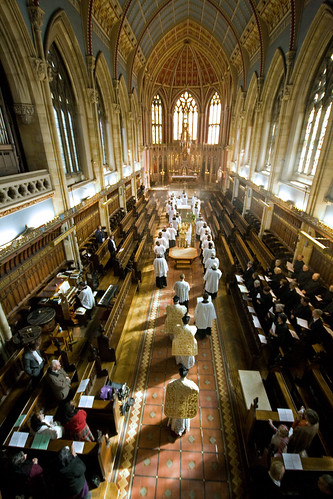
Catholic Voices has picked up some interesting statistics from the Office of Vocations. These show that, while the number of entrants into seminary and ordinations declined precipitously from the 1980s to 2000, it has crept up since then. Last year we had nearly 40 ordinations: well done to everyone who made this possible. This is not, however, news to induce euphoria: we still have a long way to go before we start replacing the priests who are retiring or dying, so many of whom, as everyone knows, were ordained in the glory days of the 1960s.
But what's this? Catholic Voices claims in its headline
'Ordinations to priesthood in England and Wales now higher than the 1950s'
The writer of this headline is displaying what one might charitably call a lack of common sense. The high number of vocations between the 1940s and 1960s is not just an urban myth: just look at the age profile of the clergy, or the physical plant they needed when at seminary. They were building new accommodation wings at Ushaw in the 1960s; they closed it down just a few years ago. The Royal College at Vallodolid, again, was once a seminary in its own right, it now functions as a venue for a propaedeutic year for seminarians - ie they go from there to another seminary. All our seminaries were established before the 20th century (Allan Hall dates from 1975, but it was just moving from Old Hall Green). Now a smaller number of them cater, not only for the seminarians of England and Wales, but also for the Scots not sent to Rome, who now go to Oscott in Birmingham.
Catholic Voices should, therefore, have realised that there is something seriously dodgy about the figures given by the Vocations Office for ordinations before 1980. The first problem is that none of their figures include religious orders, who attracted another set of vocations and put so many of their priests into parishes. These now make a far smaller contribution to our priesthood: many orders in England and Wales have either collapsed to the point of no return, or have actually ceased to exist.
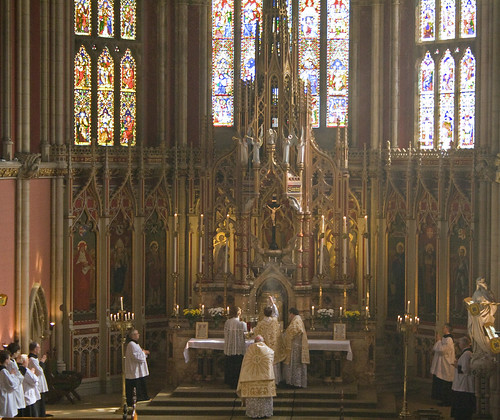
But even taking this into account - and the priests we used to get from Ireland - the Vocation Office figures are still weirdly low. They give only an 'average', decade bu decade, before the 1980s: 6 a year in the '30s, 18 for the '40s, 45 for the '50s, 65 for the '70s. At a guess, I'd say that these are figures for just one diocese or seminary, say Westminster.
The Rev. Stephen Morgan (@trisagion) has been able to get figures from old Directories which show that between 1930 & 1940 1,539 secular (diocesan) and 794 regular (religious orders) priests were ordained. For that decade, therefore, there was not an average of 18 per year for secular clergy: actually, the average was more than 150. It was more than this in the 1950s.
It is, of course, true, as Catholic Voices says, that we may want to discount the surge in vocations after the Papal Visit in 1982; by the same token we'd discount the surge of convert Anglicans following the ordination of women in the Church of England in the early 1990s, and the current surge following the debate about women bishops in the CofE. One might wonder, with all these blips, if looking at number of ordinations is really the most helpful measure of Catholic life. Why not look at numbers of baptisms, marriages, or Mass attendance?
This is what Michael Davies wrote in an appendix to his book 'Liturgical Time Bombs' (with my emphasis):
The most evident characteristic of the Catholic Church in England and Wales is that it is shrinking at an incredible rate into what must be termed a state of terminal decline. The official Catholic Directory documents a steady increase in every important aspect of Catholic life until the mid-sixties: then the decline sets in. The figures for marriages and baptisms are not simply alarming, but disastrous. In 1944 there were 30,946 marriages, by 1964 the figure had risen to 45,592-----but by 1999 it had plunged to 13,814, well under half the figure for 1944. The figures for baptisms for the same years are 71,604 (1944), 137,673 (1964), and 63,158 (1999). With fewer children born to Catholic couples each year, the number of marriages must inevitably continue to decline, with even fewer children born-----and so on. Nor can it be presumed that even half the children who are baptized will be practicing their Faith by the time they reach their teens. An examination of the figures for a typical diocese indicates that less than half the children who are baptized are confirmed, and a report in The Universe as long ago as 1990 gave an estimate of only 11% of young Catholics practicing their Faith when they leave high school.
Apart from marriages and baptisms, Mass attendance is the most accurate guide to the vitality of the Catholic community. The figure has plunged from 2,114,219 in 1966 to 1,041,728 in 1999 and is still falling at a rate of about 32,000 a year.
In 1944, 178 priests were ordained; in 1964, 230; and in 1999 only 43-----and in the same year 121 priests died.
Note that figure of 178 ordinations for 1944 Davies gives corresponds to the c.233 average for the 1940s, including regular clergy, which Rev Morgan has established, allowing for the depressing effect of the War. Numbers were presumably higher in the second half of the decade.
Would someone from the Vocations Office or Catholic Voices like to produce comparable figures for the last decade or so, so we can bring Davies' picture up to date?
I think one 'myth' which needs destroying here is that 'gloom-mongers' have ever relied just on the statistics for vocations (or ordinations), and I think that quotation from Michael Davies destroys it pretty comprehensively.
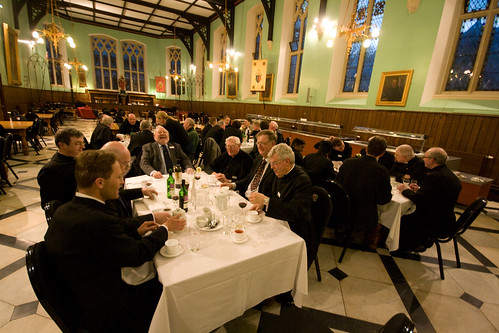
What I will say is that there are some very interesting factors at work in this peaking of numbers in the 1960s, not all to do with the Catholic Church. I will look at this in a post tomorrow. What can't be denied is that the numbers did peak at around that time.
The pictures show the Latin Mass Society Priest Training Conference in St Cuthbert's Seminary, Ushaw. Before it closed. There aren't going to be any more ordinations out of Ushaw, sadly: the cavernous chapel and refectory are silent, the side altars abandoned. The saddest thing is that its reputation for liberalism was so dire that, when it closed, many people pointed out the positive result that it would no longer serve to destroy the vocations of conservative seminarians.
The pictures show the Latin Mass Society Priest Training Conference in St Cuthbert's Seminary, Ushaw. Before it closed. There aren't going to be any more ordinations out of Ushaw, sadly: the cavernous chapel and refectory are silent, the side altars abandoned. The saddest thing is that its reputation for liberalism was so dire that, when it closed, many people pointed out the positive result that it would no longer serve to destroy the vocations of conservative seminarians.
Wednesday, April 17, 2013
Summer Events
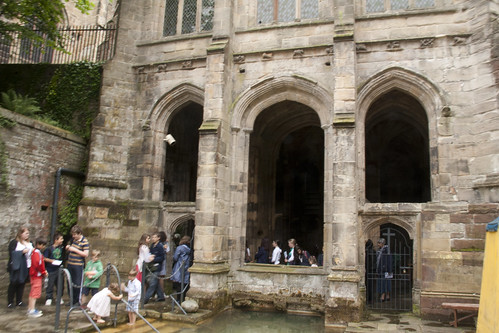 |
| The Holy Well of St Winefried, visited by the Summer School in 2012 |
Our bigger events serve additional important functions: they maintaining our holy places, and local saints and devotions, as a living part of our Catholic consciousness, they make possible liturgical events of special solemnity which might not otherwise be possible in a particular place, and they bring together people who may otherwise be isolated.
Stop thinking of excuses not to go: look at the map, and plan to go to those in your part of the country at least!
Chartres: the Chartres UK blog tells us that there are still a few places left. This pilgrimage has a special power to change your life: it is the biggest event of its kind in the world. Make yourself part of 10,000 pilgrims devoted to the Traditional Mass and the Blessed Virgin Mary. 17-21 May, but you need to book right away. I've done it a couple of times, I'll be there again this year God willing. See my posts about it.
If you miss this, or want to start with something a little easier, come with the LMS to Walsingham. 55 or so miles walking rather than 78, you don't have to cross the channel and so on. It is an unforgettable walk to a shrine which must not be forgotten: England's National Shrine to Our Lady, our own memorial of the Holy House. 23-25th August; don't leave booking till the last minute! This will be the fourth one we've done and it has been growing fast. I've been to them all so far, and should be there again. See my posts about the last one: part 1 and part 2.
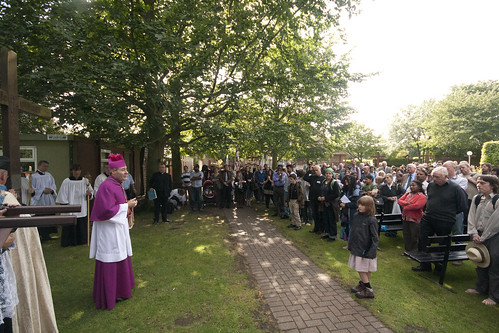 |
| Bishop Mark Davies blesses the LMS pilgrims in Walsingham, 2012 |
In honour of St Margaret Clitherow, York, 4th May.
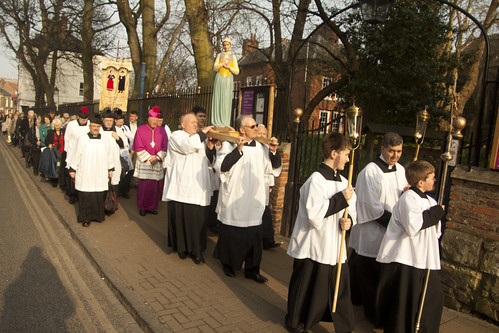 |
| Procession led by Bishop Drainey for the LMS York Pilgrimage in 2012 |
In honour of Bl John Henry Newman, Oxford 4th May (I'll be giving more details on this blog).
To Our Lady of Willesden: 22nd June. This is the revived Medieval Shrine visited by St Thomas More; it is in North West London.
Pilgrimage to Padley Chapel, in honour of the Padley Martyrs, Sunday 23 June; Missa Cantata at 1.00pm
To the Medieval Shrine of St Winefried at Holywell in North Wales, 7th July
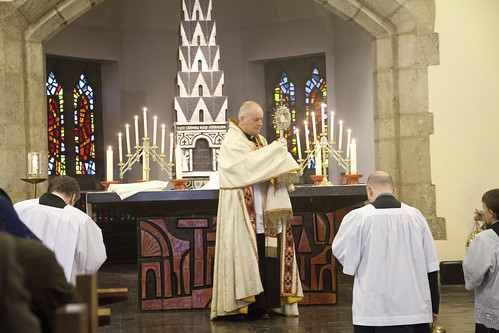 |
| Fr Tim Finigan gives Benediction at the LMS Pilgrimage to Aylesford |
In honour of the Catholic Martyrs of Oxford, 26th October.
 |
| Mass in Blackfriars, Oxford, for the Oxford Pilgrimage |
LMS Latin Course 22nd to 27th July: polish up your Latin with Fr John Hunwicke!
SCT Summer School 21st-28th July: for children from 11 to 18, in Pantasaph in North Wales, supported by the Latin Mass Society and FREE. This is a truly unique opportunity for an exploration of Catholic life and culture in the context of the traditional Mass, sung every day.
Annual Mass in Downside Abbey, 4th May.
 |
| Pontifical Mass in Downside Abbey, for the LMS Priest Training Conference in 2010 |
LMS AGM 8th June, St George's Cathedral Southwark
Annual Mass in Portsmouth Cathedral, 27th October
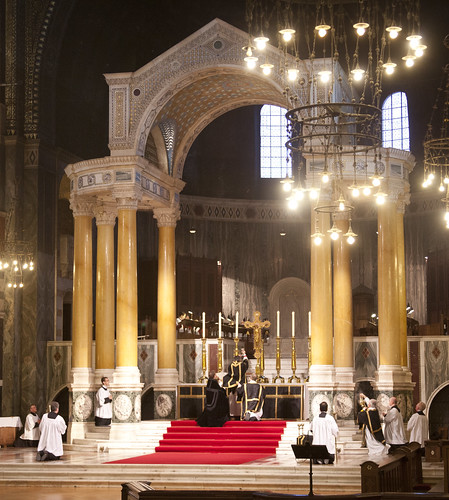 |
| Annual LMS Requiem in Westminster Cathedral, 2012 |
Monday, April 15, 2013
Death of Sir Colin Davis, petitioner for the Latin Mass
 Sir Colin Davis, a non-Catholic, signed the 1971 petition for the preservation of the Latin Mass which was organised by the Latin Mass Society. This petition is of huge significance in the history of the traditional movement, since it led, in the same year, to the 'English Indult' of Pope Paul VI, which made provision for the continuing use of the ancient liturgical tradition.
Sir Colin Davis, a non-Catholic, signed the 1971 petition for the preservation of the Latin Mass which was organised by the Latin Mass Society. This petition is of huge significance in the history of the traditional movement, since it led, in the same year, to the 'English Indult' of Pope Paul VI, which made provision for the continuing use of the ancient liturgical tradition.Recently I blogged about the death of another petitioner, William, Lord Rees-Mogg, most famous as a legendary editor of The Times. I said then that the only petitioner I was sure is still alive is Vladimir Ashkenazy, but it seems Magdalen Goffin now has a Wikipedia page, and also a page on Faber and Faber's site, and seems to be still with us. I'd also be interested to hear more about Martin Turnell, the author of 'The Rise of the French Novel' and many other works; his publisher hasn't managed to write even a brief biography.
 |
| Martin Turnell |
The ancient Mass can still be recognised, by people of culture and sensitivity, as a carrier of truly profound values. It goes without saying that the same judgement is made by the thousands of faithful Catholics, of all ages, cultures, educational backgrounds, and walks of life, who attend it, but we are used to being dismissed as insignificant. No one can dismiss Sir Colin Davis. May God reward him for his support for the Mass at that moment of supreme crisis, which it looked as though it was about to disappear forever.
Requiescat in pace.
Here he is conducting the Introit of Mozart's Requiem (h-t Damian Thompson).
Sunday, April 14, 2013
More from the Ratcliffe Conference
Ratcliffe College, and particularly the chapel with its five side chapels and two sacristies, was buzzing with activity during the conference, with all sorts of training going on and a full set of liturgies. There were about 60 people in all, including tutors and those being training, lay and clerical, and Mike Forbester's singers, all eating together and enjoying a convivial atmosphere in the evenings. What is irreplaceable about these conferences are the things which flow from getting a whole lot of priests, servers, and singers, together in one place: on the one hand, the opportunity for a wide range of liturgies, such as Solemn Mass and Offices, and on the other hand the social aspect, the chance for participants to meet like-minded priests and laity.
As well as the Pontifical Mass and the server and priest training I have blogged about, we also had Lauds each morning and Vespers each evening, and one celebration of Benediction.
We had a more formal dinner on the final evening, where, for reasons best known to himself, Fr Dunne from Glasgow gave us a spirited rendition of Robert Burns' poem 'Tam O'Shanter.' Well, it was that kind of evening. We also sang Faith of Our Fathers and Full in the Panting Heart of Rome ('God Bless the Pope!')
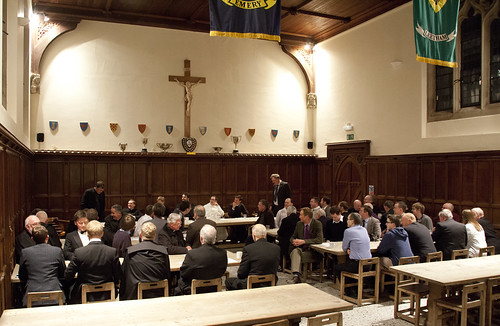
Fr Cahill celebrated a Missa Cantata on Tuesday.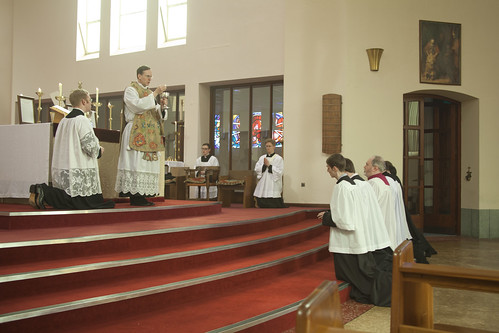
The final liturgy of the conference, however, was a Solemn Requiem.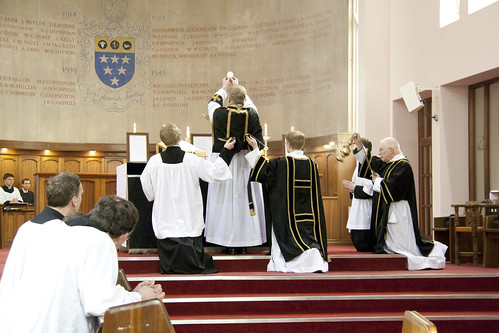
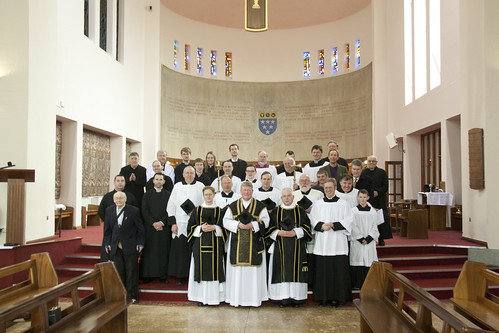
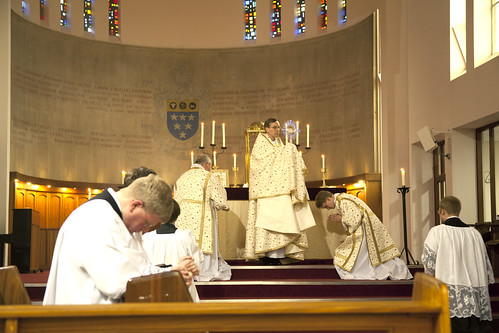 |
| Benediction, celebrated by Fr Cahill |
 |
| Vespers |
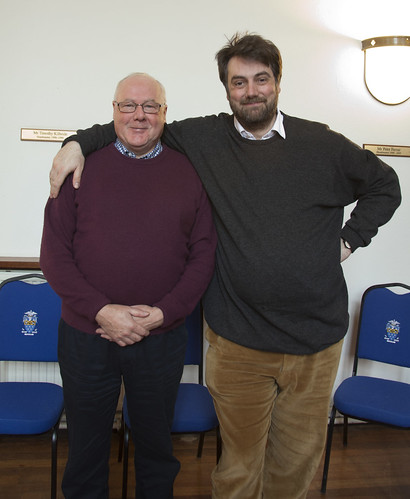 |
| Me and Fred Stone, Chairman of Una Voce Scotland |

Fr Cahill celebrated a Missa Cantata on Tuesday.

The final liturgy of the conference, however, was a Solemn Requiem.


Priest and server training at Ratcliffe
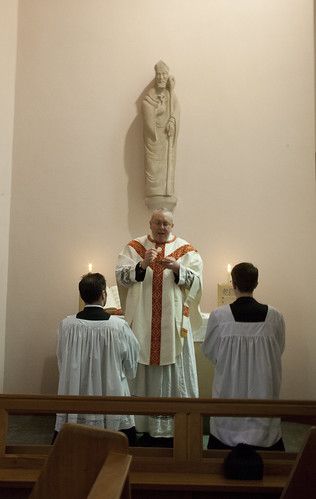 |
| Low Mass with two servers, chapel of St Chad |

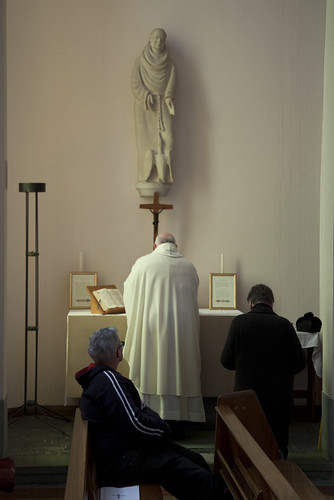 |
| Low Mass in the Chapel of St Cuthbert |
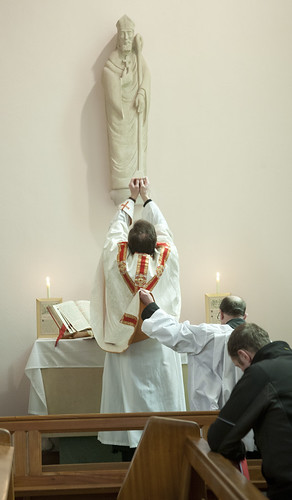 |
| Low Mass |
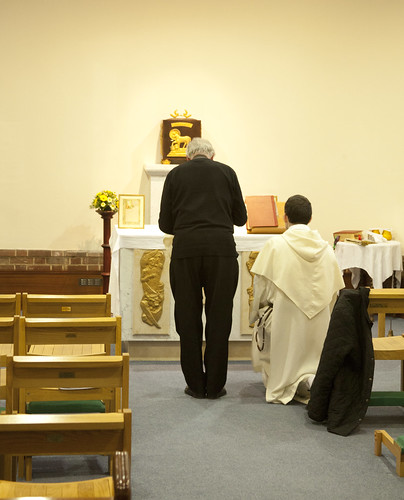 |
| A 'dry', practice Mass, with Fr Crean OP in attendance, Blessed Sacrament Chapel |
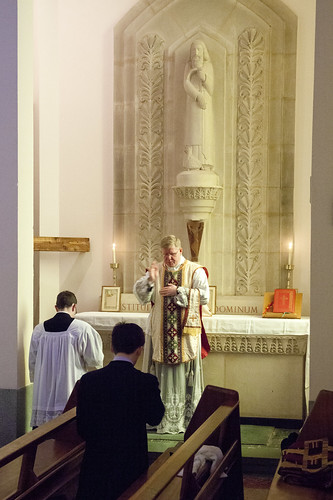 |
| Low Mass in the Chapel of St Joseph |
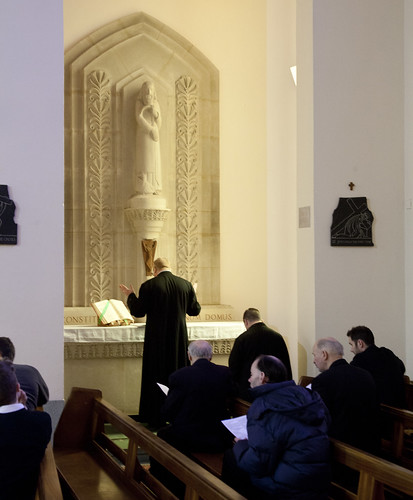 |
| A laymen demonstrates to trainee servers |
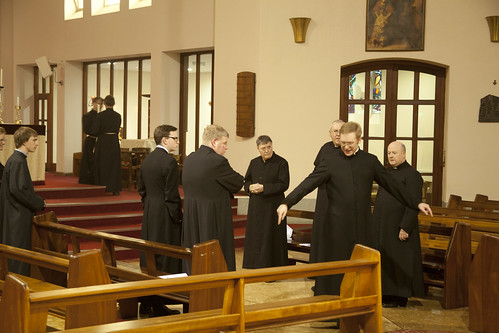 |
| The MC goes through the ceremonies of a Solemn Mass to follow |
 |
| Low Mass in the chapel of St Thomas More |
 |
| Rehearsing a chanted lection |
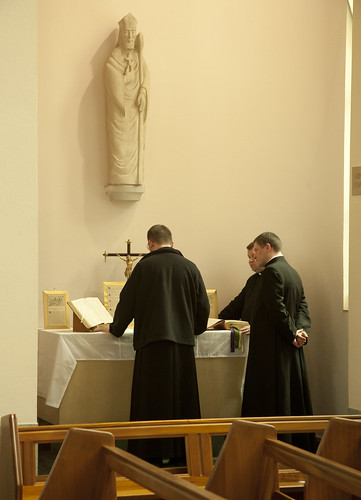 |
| Two priests running through Low Mass with a priest tutor |
Subscribe to:
Comments (Atom)












